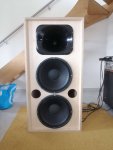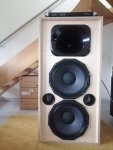I decided I needed a decent cost-effective loud drum fill. This is what I came up with and I though some others on this forum may be interested.
1 x Box 1220mm high x 550mm wide x 500mm deep
2 x ports – 100mm dia 80mm long plastic pipe
1 x BMS 4592nd + BMS HF crossover 16 ohms
http://www.bmsspeakers.com/index.php?id=bms_4592nd
2 x Faital Pro 15hp1060
https://faitalpro.com/products/files/15HP1060/8/15HP1060_datasheet_8.pdf
1 x EV HP940 ( had to cut a little of the side off to get it to fit}
https://www.electrovoice.com/binary/HP940_Horn_EDS.pdf
1 x Behringer iNuke 6000 DSP
The design
In my opinion the traditional double 15” + horn speakers don’t really work. The two 15” drivers don’t play well together above 500Hz and their directivity and the phase cancellation between the two 15's becomes problematic. The trick with this design was to find a horn and compression driver that can cross happily that low and still produce serious SPL. In this case I have selected 600Hz crossover as a bit of a compromise - not perfect, but it seems to work well enough.
Being intended for use as a drum fill I could not afford the latency associated with FIR filters and a cheap solution was to use a Behringer iNuke 6000 DSP to provide amplification, crossover, PEQ and limiting … I know, not the best solution but cost effective and simple.
Here are the results. I actually managed to get a slightly better frequency response (40Hz to 20KHz +/- 1.5 dB at the drummer ear ) but did not save the screen shoot.
) but did not save the screen shoot.
1 x Box 1220mm high x 550mm wide x 500mm deep
2 x ports – 100mm dia 80mm long plastic pipe
1 x BMS 4592nd + BMS HF crossover 16 ohms
http://www.bmsspeakers.com/index.php?id=bms_4592nd
2 x Faital Pro 15hp1060
https://faitalpro.com/products/files/15HP1060/8/15HP1060_datasheet_8.pdf
1 x EV HP940 ( had to cut a little of the side off to get it to fit}
https://www.electrovoice.com/binary/HP940_Horn_EDS.pdf
1 x Behringer iNuke 6000 DSP
The design
In my opinion the traditional double 15” + horn speakers don’t really work. The two 15” drivers don’t play well together above 500Hz and their directivity and the phase cancellation between the two 15's becomes problematic. The trick with this design was to find a horn and compression driver that can cross happily that low and still produce serious SPL. In this case I have selected 600Hz crossover as a bit of a compromise - not perfect, but it seems to work well enough.
Being intended for use as a drum fill I could not afford the latency associated with FIR filters and a cheap solution was to use a Behringer iNuke 6000 DSP to provide amplification, crossover, PEQ and limiting … I know, not the best solution but cost effective and simple.
Here are the results. I actually managed to get a slightly better frequency response (40Hz to 20KHz +/- 1.5 dB at the drummer ear
Attachments
Last edited:







